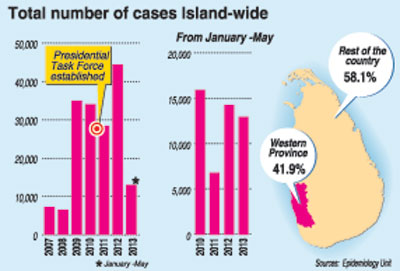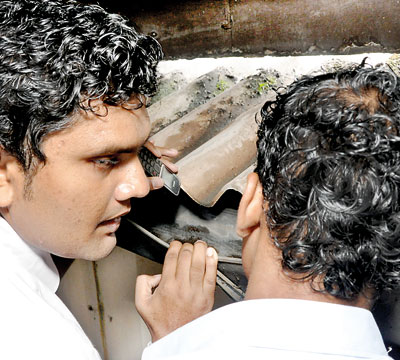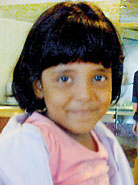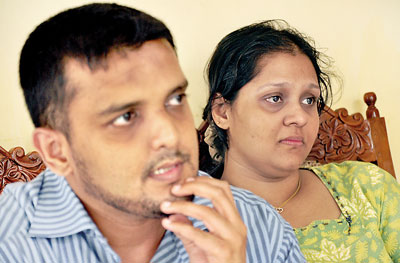News
Dengue: Cure appears successful, prevention dogged by complacency, lack of staff
Child’s death due to improper diagnosis of illness?
Their home down Dharmarama Road, Colombo 6, is strangely silent. Where there was children’s laughter and play, now there is only deep sorrow and mourning. For, the daughter of Fauzaan Farook and Fathima Naseem who would have celebrated her 6th birthday this month is no more. Little Liyana Maleeka is a child-victim of dengue.
These days, dengue deaths like Liyana’s are few and far between particularly in the State health sector as government doctors and nurses treat successfully the men, women and children with dengue, flooding the hospitals, it is understood. The general consensus, however, is that this in itself may have resulted in both the authorities and the public, who should prevent the scourge of dengue, becoming complacent.
As dengue numbers began flying high, the Sunday Times investigated what had gone wrong, even after the establishment of the powerful Presidential Task Force on Dengue in May 2010. A close look at the figures indicate a drop in the cases reported in 2011 but a major rise, a near doubling in 2012, with 2013 showing a similar trend.

Even as the authorities and the public blamed each other, the clear answer was that something had gone wrong on the side of prevention.
There are too many high-level meetings and too much report writing but little work at ground-level where the dengue mosquito-breeding takes place, said a source, while another pointed a strong finger at the dengue-garbage link.
“We need a national garbage collection and disposal plan. Even a drop of water on discarded polythene is adequate for the mosquito to breed,” he reiterated, adding that going into action when the rains begin is just not good enough. “The Task Force needs to be vigilant throughout the year for the prevention campaign to be a success, while making people aware over and over again to keep their spaces free of breeding sites.”
The Task Force, according to reports, was set up as the Dengue Control Programme was limited to a few days or weeks. The mandate of the Task Force, a network of all relevant stakeholders, is to carry out dengue-related programmes not only countrywide but also throughout the year. The stakeholders include Health, Defence, Environment, Education and Local Government & Provincial Councils Ministries.
A document on a meeting of the Task Force has 73 high-profile names and institutions. So why can’t Sri Lanka keep down its dengue numbers? The Sunday Times contacted several stakeholders to ascertain what has been happening at ground-level, apart from the paper work that is being generated by these meetings.

The Task Force, according to an Education Ministry source, issues weekly circulars on the prevention of dengue, through the ministry to schools under it. Each school has a ‘dengue-teacher’ to monitor the programme, while education officials visit schools to ensure prevention. Schools also have shramadana committees.
However, just this week, with the dengue-incident rate rising in the City of Colombo, the Colombo Municipal Council’s Public Health Inspectors (PHIs) who visited 58 schools to check for breeding areas took legal action against eight and issued warnings to 29.
This is just one instance of many where the Task Force stakeholders have failed, a source pointed out.
The Environmental Ministry, meanwhile, told the Sunday Times that it would be supporting the CMC in a garbage-separation programme from June 1.
Blaming the high rainfall for an increase in the dengue mosquito numbers, the source said that the ministry would be taking another look at the Policy on National Waste while steps would be taken to make sure that the gem pits in places like Ratnapura don’t turn into breeding areas. Schoolchildren would also be mobilised in waste separation so that they would take this message home and educate their parents.
With the setting up of the Task Force, the Defence Ministry established the Environment Police in August 2010 to help the local government authorities and a Steering Committee in August 2011 to tackle dengue. This committee holds monthly meetings to monitor progress and coordinates with the police in the implementation of an accelerated prevention programme, said Additional Secretary (Police and Civil Security) Damayanthi Jayaratne in a discussion with the Sunday Times. The others who took part were Superintendent of Police Quintus Raymond of the Environment Protection Division, Senior Assistant Secretary Saman Dissanayake and Assistant Secretary Madushanka Dissanayake.
According to these officials the Health Ministry set out an Action Plan for Dengue in 2011, focusing first on the Western Province due to the large number of cases in the area and then moved into the Eastern Province. The Environmental Police, the Medical Officers of Health (MOHs), PHIs, Grama Niladharis (GNs), Samurdhi Officers and volunteers conduct house-to-house campaigns.
On March 19, this year, the Task Force issued a circular to provincial, district and divisional committees to ‘clean their environment and make it a dengue-free zone’, said Ms. Jayaratne, adding that although it is impossible to eradicate dengue, it is possible to control it.

A PHI and a CMC doctor checking the gutters and roof of Ananda Balika Vidyalaya, Maradana. Pic by Indika Handuwala
They have conducted a major shramadana campaign in the Kurunegala district, while in the Gampola area they had mobilized more than 4,000 people to clean up their surroundings, she said, pointing out that unauthorised structures which are not maintained, neglected lands and the drainage system all aid the spread of dengue.
She conceded that insufficient staff numbers for the campaigns have had a negative effect. The attitudes of the people should change for development to take place, while keeping the environment clean. For the Task Force to succeed it needs the cooperation of all the stakeholders.
Meanwhile, Local Government and Provincial Councils Ministry Secretary R.A.A.K. Ranawake, explaining the mandate of his ministry as part of the Task Force said it was to provide guidelines and policies to counter dengue through the Provincial Councils (PCs). The individual PCs, through their Dengue Review Committees must ensure that infrastructure is in place to fight dengue through the 335 local government bodies, which include 23 Municipal Councils (MCs), 41 Urban Councils (UCs) and 271 Pradeshiya Sabhas (PSs). This committee will give directions to the local government bodies which in turn will activate the MOHs, PHIs and GNs.
The Secretaries of the Provincial Ministries of Health have to make sure the guidelines are implemented and report directly to the central Health Ministry, which will then report to the Task Force.
His ministry’s role is to assist the Health Ministry to go to the grassroots through the local government bodies in connection with garbage disposal, cleaning up of drainage systems and awareness campaigns, Mr. Ranawake said.
He explained that all MCs have been asked to collect garbage once a week, but it is not being done in some areas as there is no plan. Over 6,000 metric tonnes of garbage are collected per day island-wide and a dearth of manpower makes it difficult to cope.
Mr. Ranawake believes that the Task Force has been successful in bringing down the number of dengue deaths but could not understand why the disease numbers are high. “The infrastructure needs to be strengthened and proper architectural designs put in place to prevent water collecting and acting as breeding grounds.
The garbage issue also needs to be addressed better. However, at the end of the day the people should make sure that their homes are kept clean throughout the year and not only when dengue figures rise,” he added.
Treatment of dengue in State hospitals good
Dengue control needs to be looked at in a different way, said the Director-General of Health Services, said Dr. Palitha Mahipala, pointing out that even countries such as Thailand, Singapore and Malaysia have not been able to curb it.
On the part of the Health Ministry, patient management has been strengthened, cutting down the death rates, while facilities have also been strengthened, he said, adding that 165 Dengue High Dependency Units have been set up in hospitals across the country. There are Dengue Death Reviews to find out what went wrong and learn from such incidents.
When asked whether, private hospitals are reporting dengue numbers as diligently as government hospitals, the Director-General said it was happening but not that effectively. The case fatality has come down from 1% to 0.3% and the ministry is making a concerted effort to bring it down further to 0.1% soon, Dr. Mahipala assured.
Mopping up quick, but prevention has issues
Although PHIs go into shanties to get them to clean up, how effective the work is would differ from one PHI to another, said Dr. Amal Harsha de Silva, Provincial Director of Health Services of the Western Province,
Referring to primary prevention of dengue, he said that when notification comes on e-mail — a measure taken by the Task Force — about a dengue patient, the Rapid Deployment Unit comprising 150 members get mobilised within three days to carry out mopping up operations around the patient’s home to get rid of the mosquitoes. Earlier the hospital filled up a notification form and sent it to the MOH of the area, with mopping up by the PHIs taking place in around two weeks.
Periodical surveys are also done, according to him, with the number of breeding sites and mosquito density being gauged in a particular area. If the value is high, clean-up operations need to kick in. The law has also been strengthened after 2010 and people harbouring breeding places charged under the Public Nuisance Prevention Ordinance.
Meanwhile, Dr. Shanthi Samarasinghe, Secretary, Provincial Ministry of Health of the Central Province, stressing that there has been a decline in dengue numbers after the Task Force was set up, said mopping up would cover 25 houses around the home from which the patient came.
However, the garbage handling of the province needs to be given attention, Dr. Samarasinghe said, calling for more awareness among the public to keep their homes and the environment free of breeding sites.
Colombo lacks staff to tackle dengue well
Lamenting the lack of staff, the Colombo Municipal Council’s Chief Medical Officer Dr. Pradeep Kariyawasam said to tackle dengue effectively he needed midwives, clerks, public health inspectors and health instructors. But he is working at 50% strength and there are about 100 vacancies for health instructors.
With the city having 120,000 premises, the MOHs were stretched and the lack of vehicles aggravated the problem. The aerial spraying of the biological larvicide Bti (Bacillus thuringiensis israelensis) has been stopped and although ground-level spraying continues, it is difficult to reach every nook and corner of a house, he said.
Countries like Cuba are successful because they have volunteers who clean the streets and check houses. We need to hire young people, pay them an allowance and get street-by-street inspections done, said Dr. Kariyawasam.
He too echoed the view that solid waste needs to be taken out of homes and dealt with; arrangements made for people to notify the authorities about neglected homes and gardens whenever they go abroad for long periods; and laws strengthened to punish people who allow mosquito breeding in their homes.
Urging that each sector must ensure that they prevent the spread of dengue, he cited the example of the need for transport services to be vigilant to keep trains and buses free of mosquitoes and ensure that they do not bring mosquitoes from one area to another.
Serious lack of public awareness
Lack of awareness, not cleaning up clogged drains and poor garbage disposal are some of the reasons for the dengue issue, was the view of people surveyed by the Sunday Times at the Fort Railway Station.

Little Liyana Maleeka: Not yet 6 when death took her away
H.F Wanigasekara (67) of Avissawella, J. Rajapakse (57) of Meerigama, G.K.G. Indrani Herath (32) of Gampaha, Thibiriyagama Bandara (53) of Mattegoda, Zafreen Sheriff (26) of Kolonnawa, N. Thirunawukarasu (65) of Kalmunai, V. Jeyaruban (38) of Wellawatte and Waruna Indika Hettiarachchi (32) of Panadura urged more measures to make the public aware about prevention.
It should also be around the year, some of them said, pointing out that even though they cleaned up their homes, their neighbours did not. For town planner H.M. Herath (40) of Kottawa and Mohammed Cassim Meera Mohideen (47) of Batticaloa there is a link between waste management and dengue. Current methods of waste disposal are not effective.
Bandara pointed out that a dengue poster in front of the post office is covered with branches, while Zafreen said the 10ft. high garbage dump at Thotalanga which has now been moved to Kolonnawa is 50ft. high, aiding the spread of dengue. Undergraduate Chathura Silva (24) of Matugama, who has been affected by dengue, said current practices are not effective. Tough regulations are essential. His university takes precautions only when the risk is high.
Prevention is effective, say housewife Sriyani Bandara (27) of Polhena whose 1½-year-old baby was affected by dengue, a view echoed by student Gayashan Sanjaya (19) of Bentota, who also dengue along with his sister and uncle while they were in Avissawella.
Questions arise over private hospital management of dengue

The sorrowing mother and father. Pix by Amila Ganage
The fever gripped Liyana Maleeka on May 19 and she began vomiting. Her father Fauzaan Farook and mother Fathima Naseem took her immediately to a private hospital.
The doctors said it could be viral flu but no one mentioned dengue or that there was a test for dengue that can be done even on the first day of fever, says Fauzaan. After checking her liver area, her paediatrician had prescribed antibiotics for her cough as she was also prone to asthma.
By Tuesday morning her fever had dropped but she complained of a stomach-ache. The paediatrician then ordered another medication and the family gave that as well as the antibiotics, but the pain didn’t ease. When they rushed her to a different private hospital this time, the medical staff paid no heed to the child’s fingers becoming pale and limbs growing cold, he says.
Although they started a drip, there was not much monitoring, it is learnt. It was when a blood test showed the platelet count to be 29,000 that there was panic. The cannula for the saline drip had come off and the staff struggled to put it back, but failed. In desperation, they took her to the ICU and kept trying while the child shouted in agony, he says, adding that the private hospital mentioned that they are not equipped to handle such cases.
Liyana was then transferred to the Lady Ridgeway Hospital for Children without a drip and for the parents consolation came when they saw the efficiency and professionalism of the LRH staff.
What they didn’t know at that time was that the child, although talking to them normally, had gone into shock before being brought to LRH and the major effort by the LRH staff to save her life would be futile.
Follow @timesonlinelk
comments powered by Disqus

